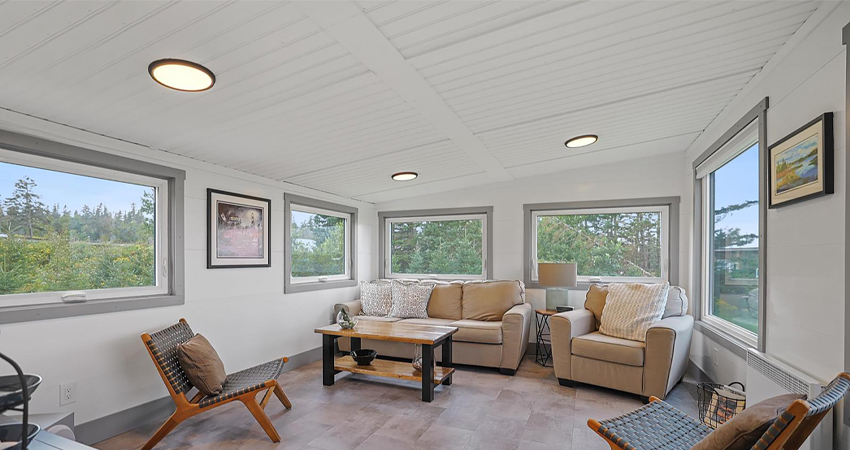Hurricane season runs from June 1 to November 30, typically bringing an average of 14 named storms, seven hurricanes, and three major hurricanes making landfall in North America each year. Within these six months, billions of dollars in damages occur, and countless homeowners face the daunting task of repairing or rebuilding their homes.
These powerful storms bring heavy rains, strong winds, and storm surges that can devastate homes and communities. In this blog post, we explain how you can hurricane-proof your home by building with stronger materials. Plus, we cover some cost-effective steps and items you can buy to protect yourself and your home if large-scale renovations aren’t in your budget to help you stay ahead of the storm.

Understanding Hurricane Risks
When a hurricane hits, it brings with it a host of dangers that can threaten both your home and your safety. Let’s break down the primary risks associated with hurricanes:
- High Winds: Hurricanes can produce sustained winds exceeding 100 mph, capable of ripping roofs off houses, toppling trees, and turning everyday objects into deadly projectiles.
- Flooding: Heavy rainfall and storm surges can lead to severe flooding, which can inundate homes, damage foundations, and disrupt utilities.
- Flying Debris: Objects caught in the wind, like tree branches, outdoor furniture, and even construction materials, can become airborne and cause significant damage to structures and injury to people.
To truly grasp the severity of these risks, let’s look at some recent statistics and examples:
- Hurricane Ian (2022): This Category 4 hurricane caused widespread devastation in Florida, resulting in over $50 billion in damage. High winds and storm surges led to extensive flooding, especially in coastal areas.
- Hurricane Harvey (2017): Striking Texas, Harvey brought unprecedented rainfall, with some areas receiving over 40 inches. The flooding was catastrophic, damaging or destroying over 200,000 homes and causing $125 billion in damage.
- Hurricane Laura (2020): This Category 4 storm hit Louisiana hard, with sustained winds of 150 mph. It caused significant structural damage from both winds and flooding, leading to widespread power outages and more than $19 billion in damages.
These examples highlight why understanding and preparing for hurricane risks is crucial. By taking the right precautions, you can mitigate the potential damage to your home and protect your family from the severe impacts of these powerful storms.
How to Inspect and Prepare Your Home Ahead of Hurricane Season
Before hurricane season hits, conduct a thorough inspection of your home to identify and address any vulnerabilities. Here’s a step-by-step guide to help you pinpoint potential weaknesses and make any necessary upgrades you need.
Reinforce Your Roof to Protect Your Home from High Winds and Heavy Rain
High winds from hurricanes can exert tremendous pressure on your roof. If your roof isn’t properly secured, the wind can lift shingles, tiles, or even large sections of the roof, leading to leaks, structural damage, and potentially a total roof collapse. A well-secured roof can significantly reduce the risk of extensive damage to your home. Here are six tips on how to reinforce your roof ahead of hurricane season:
- Inspect and Repair: Regularly inspect your roof for any loose or missing shingles, tiles, or panels and repair them promptly. Check for rusted or damaged flashing and replace them to maintain a watertight seal.
- Install Hurricane Straps: Hurricane straps, also known as hurricane ties or clips, are metal connectors that securely attach your roof to the walls of your home. These straps can help keep your roof intact during high winds.
- Seal the Roof Deck: Apply a self-adhering membrane or roofing tape to the seams of your roof deck. This added layer of protection can prevent water from seeping into your home if the outer roofing material is damaged.
- Reinforce Shingles and Tiles: Use roofing cement or adhesives to reinforce the edges of shingles and tiles, reducing the likelihood of them being torn off by strong winds.
- Upgrade to Impact-Resistant Materials: Consider upgrading to impact-resistant shingles or metal roofing. These materials are designed to withstand higher wind speeds and the impact of flying debris.
- Clear Gutters and Downspouts: Make sure your gutters and downspouts are free of debris to ensure proper water drainage. This helps prevent water from backing up and causing roof leaks.


Secure Your Windows and Doors to Keep Wind and Water Damage to a Minimum
Sturdy windows and doors are crucial in preventing wind damage during a hurricane. High winds and flying debris can easily shatter standard glass, allowing wind and water to enter your home and cause extensive damage. Here are five tips to help you batten down the hatches and protect your home’s windows and doors:
- Install Impact-Resistant Glass: Impact-resistant windows and doors are designed to withstand the force of flying debris. These products have a layer of durable plastic between two panes of glass, which helps absorb impact and prevent shattering.
- Use Storm Shutters: Permanent storm shutters made of aluminum or steel can be quickly deployed when a hurricane approaches. They provide a robust barrier against wind and debris. Accordion shutters, roll-down shutters, and colonial shutters are popular types of storm shutters that offer varying levels of protection and convenience.
- Plywood Covers: If you don’t have storm shutters, covering windows with plywood is an effective temporary measure. Use 5/8-inch plywood, cut to fit each window, and secure it with screws or bolts. Install these covers well before the storm arrives for maximum effectiveness.
- Reinforce Garage Doors: Garage doors are often the largest opening in a home and can be a weak point during a hurricane. Reinforce your garage door with a bracing kit, which includes horizontal and vertical supports to strengthen the door against wind pressure. Consider upgrading to a hurricane-rated garage door, designed to withstand high winds and prevent blowouts.
- Seal and Secure Doors: Ensure all exterior doors have at least three hinges and a deadbolt lock with a bolt at least one inch long. Install door sweeps and weather stripping to keep out water. For double-entry doors, secure the inactive door with heavy-duty bolts that slide into the floor and frame.
Protect the Inside of Your Home Against Hurricane Flooding
Flooding is one of the most damaging aspects of a hurricane, often causing extensive and costly repairs. Implementing effective strategies to minimize flood damage can save homeowners significant time and money. Here are some key measures to protect your home against flooding and to minimize damage if water finds its way in:
- Install Sump Pumps: A sump pump installed in your basement or crawlspace can help remove water that accumulates during heavy rains. It’s a crucial defense against flooding, especially in low-lying areas. Also consider buying a battery-operated backup sump pump to ensure continuous operation during power outages, which are common during hurricanes.
- Backflow Valves: Install backflow valves on your sewer lines to prevent floodwaters from causing sewage to back up into your home. There are several types, including flap, gate, and pressure valves — consult with a plumber to determine the best option for your home.
- Elevate Utilities and Appliances: Place water heater and furnace units on platforms or relocate them to higher floors if possible. Keeping them above potential flood levels helps prevent damage and keeps essential systems operational. Raise electrical components, including panels, switches, and outlets, to at least one foot above the base flood elevation to reduce the risk of water damage and electrical hazards.
- Install PVC Panels on Top of Drywall: Installing flood-resistant materials like Trusscore Wall&CeilingBoard PVC panels on top of drywall can protect your space from water damage and mold growth. Non-porous and antimicrobial Trusscore panels are 100% waterproof, install with a watertight seal, can withstand long-term exposure to flood water filled with bacteria and chemicals, and will never grow mold or mildew. Plus, Trusscore panels can be cleaned and disinfected with soap and water or with high-strength chemical cleaners to return them to their original state. No replacement or patching needed.
- Seal Cracks and Gaps: Inspect and seal any cracks in your foundation, walls, and around windows and doors. Use waterproof sealants to prevent water from seeping into your home.


Harden Your Home’s Interior for Hurricane Season with Trusscore Wall&CeilingBoard
Hurricane floodwater wreaks havoc on drywall — it swells, loses its strength, absorbs bacteria and chemicals, and becomes a breeding ground for mold in just 24 to 48 hours. Made from PVC, pre-finished Trusscore Wall&CeilingBoard panels are the perfect, flood-resistant alternative for homes in hurricane-prone states.
Strengthen the Exterior of Your Home to Face High Winds
Strengthening the exterior of your home is vital to minimize the risk of damage from high winds and flying debris during a hurricane. In addition to the steps outlined above, here are some effective strategies to reinforce key areas of your home and secure potential projectiles:
- Secure Outdoor Furniture and Decorations: Use ground anchors or tie-downs to secure heavy outdoor furniture, grills, and large potted plants. Move smaller items, such as garden decorations, tools, and toys, indoors or into a secure shed to prevent them from becoming dangerous projectiles.
- Reinforce Fencing and Gates: Ensure that your fencing is sturdy and in good condition. Repair or replace any loose or damaged sections. Secure gates with heavy-duty latches and consider reinforcing them with additional bracing to withstand strong winds.
- Install Wind-Resistant Siding: Opt for siding materials that are designed to withstand high winds and flying debris, such as fiber-cement or reinforced vinyl siding. Ensure that siding is properly installed and securely fastened to the structure to prevent it from being ripped off during a storm.
- Strengthen Soffits and Eaves: Make sure soffits and eaves are securely fastened to the house. Reinforce with additional screws or brackets if needed to prevent them from being blown away.
For When All Else Fails, Make Sure Your Home Insurance Has You Covered
One inch of water can cost more than $25,000 in damage to a home, so it’s important to have flood insurance if you live in a hurricane-prone area.
Flood damage from hurricanes isn’t covered by standard homeowners' insurance policies. In the U.S., you’ll need a separate flood insurance policy, often available through FEMA's National Flood Insurance Program (NFIP), which protects your dwelling and its contents.
NFIP requires new homes in high-risk areas to use flood-resistant materials, defined as those that can withstand direct and prolonged contact with floodwaters for at least 72 hours without significant damage. Trusscore Wall&CeilingBoard is an NFIP-approved, flood-resistant material ideal for interior walls and ceilings.
By taking these steps, you can better protect your home and family during hurricane season. For a ballpark cost estimate for outfitting your home with Trusscore products, check out the Trusscore Project Planner.



